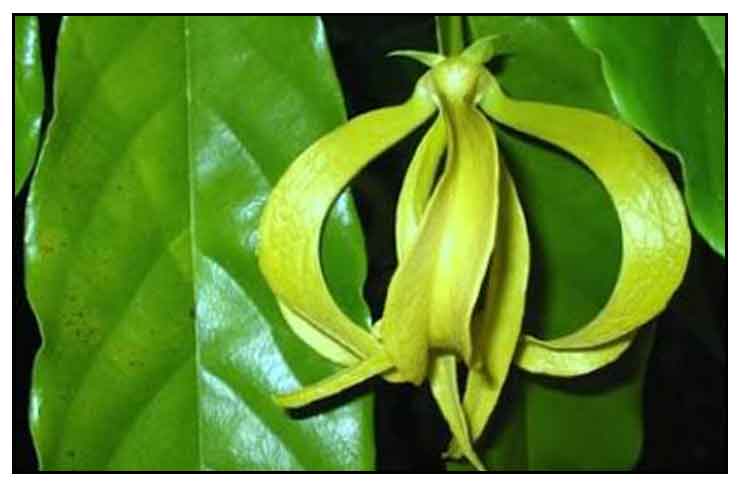|
 Gen info Gen info
- Desmos Lour. is a small genus in the family Annonaceae, comprising 25-30 species, endemic to tropical and subtropical Asia.
Botany
Ilang-ilang gubat is a rather small erect or climbing shrub, 1.5 to 3 meters height. Leaves are oblong to oblong-ovate, 8 to 15 centimeters long, pointed at
the tip and rounded at the base, and nearly smooth. Flowers are yellowish white, solitary on a 2- to 5-centimeter long peduncle,
borne opposite or nearly opposite to leaflets. Calyx are 3, ovate, 3 to
5 millimeters long. Corolla are 6, fixed, arranged in 2 whorls, oblong or oblong-lanceolate,
3 to 4 centimeters long, the outer whorl bigger than the inner one; stamens numerous.
Peduncle extra-axillary, about 5 centimeters long, with one flower. Sepals are ovate-lanceolate,
about 1.5 centimeters long. Petals are somewhat hairy, yellow, fragrant, 4 to 5 centimeters
long. Fruits are dehiscent, peduncled, arranged in dense clusters,
2 to 5 centimeters long, 1 to 7 seeded.
Distribution
- In thickets and forests at
low and medium altitudes in Palawan, Basilan, Mindanao (Zamboanga).
- Also occurs in India, Assam, and Burma to southern China, and southwards throughout Malaysia and the Malay Peninsula.
Constituents
• Fragrant flowers yield a volatile oil. Fruit also yields oil.
• Study yielded desmosic acid, a novel cytotoxic fatty acid. (3)
• Study yielded eleven compounds: lawimal, desmosal, desmethoxymatteucinol,
unonal , isounonla, desmoflavone, allantoic acid, succinic acid, daucosterol,
beta-sitosterol and stearic acid.
• Main compounds identified in young and ripened flowers were trans-caryophyllene (56.2%) and spathulenol (61.5%), respectively.
• Study of petroleum ether extract of roots yielded three flavonoids, two identified as lawinal (1) and isounonal (2).Compound 3 is a new flavonol. Spectroscopic analysis established the structure as 47- dihydroxyl-5-methoxyl-6-methyl-8-formyl-flavan. (see study below) (1)
• Major compounds in the flower oil of Desmos cochinchinensis were monoterpenoids camphor (59.1%), limonene (8.9%), α-pinene (8.6%) and camphene (6.0%). (11)
• Stem bark and fruits were evaluated for essential oil. Stem bark yielded main compounds of ß-caryophyllene (16.9%), bicyclogermacrene (11.6%) and benzyl benzoate (10.1%) while the fruit oil showed an abundance of ß-caryophyllene (20.9%), limonene (15.89%) and germacrene D (12.5%) (12)
• Study of MeOH extract of D. cochinchinensis var. fulvescens Ban yielded two new compounds: 1ß,7α-dihydroxyeudesman-4-one (1) and 5αH-megastigm-7-ene-3α,4α,6ß,9-tetrol (2) along with nine known terpenoids. (13)
• Study of essential oil extract identified -caryophyllene (56.2%) and spathulenol (61.5%) as main compounds in young and ripened flowers, respectively The oil was characterized by an abundance of α-pinene (11.5%), ß-caryophyllene (26.3%), germacrene D (14.6%), and bicyclogermacrene (11.4%). Leaves yielded low amount of essential oil (0.55% v/w; intense yellow). (14)
- Study of leaf and twig extracts isolated four new flavonoids (1-4), a new benzyl benzoate derivative (5), five new oxepinones (6-10), along with 14 known compounds (11-24). (see study below)
(15)
Properties
- Pungent tasting,
- Stomachic.
- Studies have suggested antimalarial, antimicrobial, antioxidant, aromatase and lipoxygenase inhibiting, alpha-glucosidase inhibitory activities
Parts
utilized
· Roots, stems, leaves.
Uses
Folkloric
· Decoction of dried
leaves used for gastrointestinal distention, indigestion, nephritis-edema,
bronchitis.
· Leaves used for treating bruises, pain, intestinal parasitism, rheumatism, diarrhea.
· Decoction of dried roots (15-30 g): Used for rheumatic muscular
pain.
· In Malaya, roots used for dysentery and fever.
· Decoction of roots given after childbirth; also used for vertigo.
· In Chinese folk
medicine, used for malaria.
· In Vietnam, used
as antimalarial, insecticidal, antirheumatic and analgesic. Also, leaves are used for constipation. Stems used by the Dao tribe for constipation.
Studies
• Anti-Malaria / Flavonoids / Roots:
Study isolated three flavonoids from the petroleum extract of the root
of Desmos cochinchinensis. Pharmacologic study exhibited anti-malarial
activity. (see constituents above) (1)
• Anti-Microbial :
Study on the crude extracts of DC leaves showed strong antibacterial
activity against S. aureus, S epidermis and B subtilis and strong inhibition
against all dermatophytes (2)
• Cytotoxic Cycloartane Triterpenoids:
Study isolated desmosinal, a novel cycloartane triterpenoid from the stem of Desmos cochinchinensis Lour. (3)
• Phenolic Compounds / NFAT Transcription
Inhibition : Study yielded six phenolic compounds from
the methanolic extract of the dried leaves of Dc. Of these, compounds
2 (negletein) and 3 (2',3'-dihydroxy-4',6'-dimethoxydihydrochalcone
exhibited potent inhibitory activity against nuclear factor of activated
T cells (NFAT) transcription factor. (5)
• Flavones:
Study isolated four compounds identified as 5-hydroxy-7-methoxy- 6,8-dimethylflavone (desmosflavone), unonal, desmethoxymatteucinol and beta-sitosterol. (7)
• Hybrid Flavan-Chalcones / Antioxidant / Aromatase and Lipoxygenase Inhibitors / Cytotoxic / Leaves:
Study of leaves isolated hybrid flavan-chalcones, desmosflavans A (1) and B (2), together with three known compounds, cardamonin (3), pinocembrin (4) and chrysin (5). Compounds 3 and 5 exhibited potent antioxidant activity. Compounds 1, 2, 4 and 5 were found to be inhibitors of aromatase. Desmosflavan A (1) inhibited lipoxygenase and exhibited cytotoxic activity. (8)
• Aromatase Inhibitory Activity / Roots:
Flavans from roots of D. cochinchinensis exhibited potent aromatase inhibitory activity at nanomolar levels, without pronounced cytotoxic activity. Flavans exerted their inhibitory activity through binding with aromatase at Arg115, Met374, and Leu477. (10)
• α-Glucosidase Inhibitory Flavonoids and Oxepinones / Leaves and Twigs: Four new flavonoids and five new oxepinones, and 14 known compounds were isolated from the leaf and twig extracts of D. cochinchinensis. Compounds 1, 2, 6, 8, 10, 12-15, and 17 showed α-glucosidase inhibitory activities with IC50s ranging from 0.2 to 4.9 µM. (see constituents above) (15)
Availability
Wild-crafted.
|

![]()

